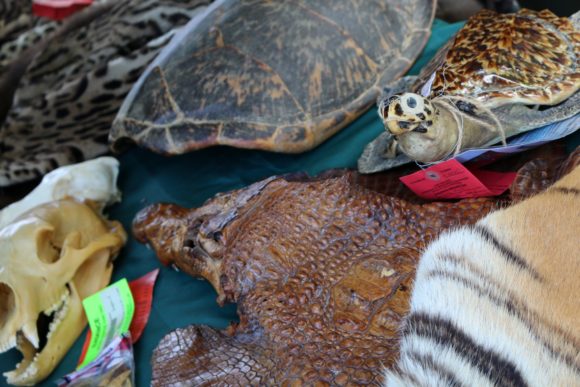There is no question that the fashion industry causes great harm to the environment. The industry’s faddish nature, combined with the overproduction of low-cost, low-quality pieces, is designed to encourage overconsumption. Production of fast fashion garments eats up precious resources, like clean water and old-growth forests, and discarded clothing can sit in landfills for hundreds of years, thanks to synthetic materials used in construction.


According to scholars Monique Sosnowski—a Ph.D. candidate in criminal justice at the CUNY Graduate Center—and John Jay Assistant Professor of Criminal Justice Dr. Gohar Petrossian, pollution is not the fashion industry’s only crime. In a new article, they investigated what species were being utilized for the fashion industry, which is worth over $100 billion globally, in order to better understand the damage the industry causes to wildlife and wild places.
Sosnowski and Petrossian looked at items imported by the luxury fashion industry and seized at U.S. borders by regulatory agencies between 2003 and 2013. Their study found that, during that decade, more than 5,600 items incorporating elements illegally derived from protected animal species were seized. The most common wildlife product was reptile skin—from monitor lizards, pythons, and alligators, for the most part—and 58% of confiscated items came from wild-caught species. The authors also found that around 75% of seizures were of products coming from just six countries: Italy, France, Switzerland, Singapore, China and Hong Kong. The heavy involvement of the European countries was unexpected, according to Dr. Petrossian, because they are key players in fashion design and production but “don’t generally come up in broader discussions on wildlife trafficking.”
THE SCIENCE OF WILDLIFE CRIME
The paper applied “crime science, a body of criminological theories that focus on the crime event rather than ‘criminal dispositions,’ to understand and explain crime. The overarching assumption is that crime is an opportunity, and it is highly concentrated in time, as well as across place, among offenders, and victims,” says Dr. Petrossian. Their scientific approach enabled the authors to analyze patterns and concentrations in wildlife crime, which Sosnowski notes is among the four most profitable illegal trades.
“We are currently living in an era that has been coined the ‘sixth mass extinction,’” she says. “It is crucial that we understand the impact that humans are having on wildlife, from habitat loss to the removal of species from global environments. Fashion is one of the major industries consuming wildlife products.”
A background in wildlife conservation, including unique experiences like responding to poaching incidents in Botswana and rehabilitating trafficked cheetahs in Namibia, led Monique Sosnowski to a Ph.D. in criminology; she wanted to move beyond a more traditional conservation-informed approach to address what she’d seen in the field. Working with Dr. Petrossian on a series of studies applying crime science to wildlife crimes has given her a broader view of the effects of wildlife-related crime on global ecosystems.
CREATING SOLUTIONS, SAVING WILDLIFE

Why is it important to understand what species are most commonly used in luxury fashion products, and where they are coming from? A study like this one provides information about trends that policymakers can use to strengthen or focus enforcement and inform better understanding of the issues. Sosnowski calls this “the key to devising more effective prevention policies.”
Currently, global regulation of the trade in wildlife products, including leather, fur, and reptile skin that come from species both protected and not, is the province of the Convention on International Trade in Endangered Species (CITES); this treaty aims to ensure that international trade in wild animals and plants does not threaten their survival. But the treaty is limited in scope.
“Given the prevalence of exotic leather and fur in fashion, we believe CITES and other regulatory bodies should enact policies on its use and sustainability in order to protect wild populations, the welfare of farmed and bred populations, and the sustainability of the fashion industry,” Sosnowski says.
Consumers also have a role to play. “We are all led to believe that products found on the shelves are legal, but as this study has demonstrated, that isn’t always the case. Consumers of these products are the ones who have the power to change the behaviors of a $100 billion industry. We need to ask questions about where our products were sourced, and respond accordingly.”
###
Summarized from EcoHealth, Luxury Fashion Wildlife Contraband in the USA, by Monique C. Sosnowski (John Jay College, City University of New York) and Gohar A. Petrossian (John Jay College, City University of New York). Copyright 2020 EcoHealth Alliance.



I’m impressed, I must say. Rarely do I encounter a blog that’s both educative and entertaining, and let me tell you, you have hit the nail on the head. Your writing is outstanding…I am happy to read this blog!!